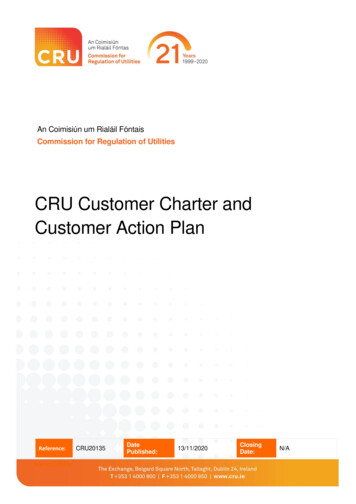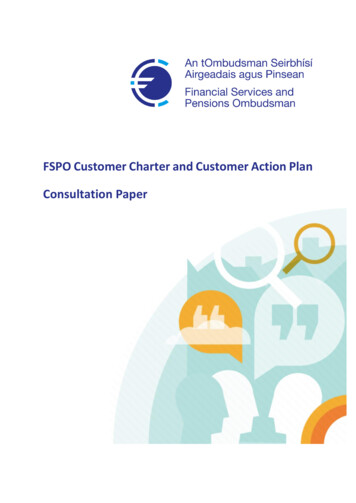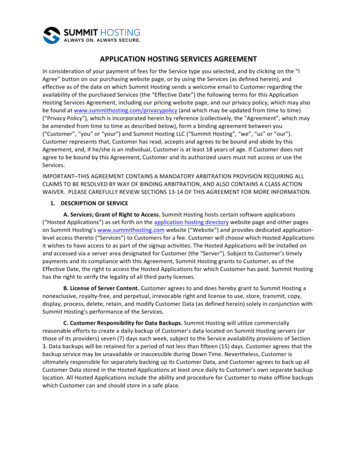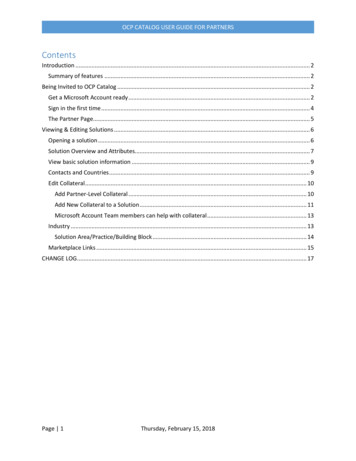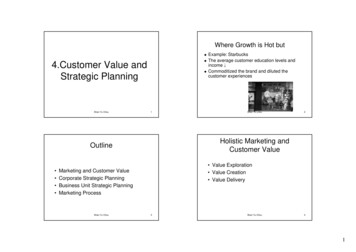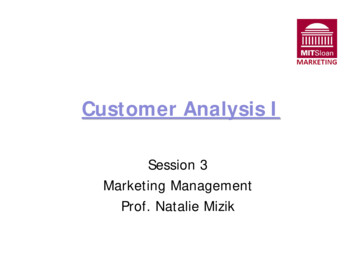
Transcription
Customer Analysis ISession 3Marketing ManagementProf. Natalie Mizik
Outline How do you think about customers?How do customers think? Overview of approaches.Focus on behavioral economics.Useful in understanding many marketingphenomena. Alternative to ‘rational’ and ‘motivational’approaches. 2Prof. Natalie Mizik – 2010 MIT 15.810
The Consumer Quiz Asked you to estimate common marketingstatisticsMeasured your confidence in theseestimatesResults?3Prof. Natalie Mizik – 2010 MIT 15.810
Key Learning You are not alone: Executives, MBA studentsin other schools make similar errors.Why do people make these “mistakes”? False consensus: believe that the othersare more like yourself than they really are Overconfidence: people believe that theyare right more often than they really are4Prof. Natalie Mizik – 2010 MIT 15.810
How do you prevent this?7Prof. Natalie Mizik – 2010 MIT 15.810
Implications for Marketing: You are a member of(at most) onesegmentPossible Solution: Customers mustprovide the data, donot rely just on yourintuitionsGlobally, mktgresearch is essential Overconfidence keepsyou from seeing thisPossible Solution: Diverse teams andinvolving customerinputs at every stage8Prof. Natalie Mizik – 2010 MIT 15.810
How Customers Think A continuum of views:RationalApproachesBounded heoryBehavioral Economicsand Behavioral DecisionTheoryFreudian andAnthropologicalApproaches9Prof. Natalie Mizik – 2010 MIT 15.810
The Standard EconomicTheoryCustomers assessoptions relative totheir net worthUtility Wealthq1 Pick the best optionto maximize utilitysubject to budgetconstraintq*1q*2q210Prof. Natalie Mizik – 2010 MIT 15.810
Motivational Approaches People are less than rational, driven byunconscious and uncontrolled motivationsBest studied by observationExamples of motivational approaches For the ladies: Diet Coke (USA)For the fellas: Tuborg beerFear appeal: Aussie underpantsFear appeal: More Australian underpants (Underdaks)Fear appeal: Philippines anti-smoking11Prof. Natalie Mizik – 2010 MIT 15.810
Behavioral Approaches People, because of limited processingcapacity, use simplified ways of makingdecisions12Prof. Natalie Mizik – 2010 MIT 15.810
Behavioral Approaches:Prospect Theory Value is judgedrelative to areference pointLosses loomlarger than gainsValuelossgain(estimates range 2.0-2.5) DiminishingsensitivityReferencepoint can beshifted“Value” function (similar to utility function)13Prof. Natalie Mizik – 2010 MIT 15.810
Three concepts from PT Reference pricingFramingLoss aversionDo these apply to you?14Prof. Natalie Mizik – 2010 MIT 15.810
A beer at the beach .Reference Price MattersYou are lying on the beach on a hot day. All you have to drink is ice water. Forthe last hour you have been thinking about how much you would enjoy a nicecold bottle of your favorite brand of beer. A companion gets up to go make aphone call and offers to bring back a beer from the only nearby place where beeris sold, [a fancy resort hotel] [a small, run-down grocery store]. He says that thebeer might be expensive and so asks how much you are willing to pay for thebeer. He says that he will buy the beer if it costs as much or less than the priceyou state. But if it costs more than the price you state he will not buy it. Youtrust your friend and there is no possibility of bargaining with the [bartender][store owner]. What price do you tell him?HotelCBS 20099.38Store7.40Cornell MBA’s 1985Store: 1.50Hotel: 2.65Prof. Natalie Mizik – 2010 MIT 15.810Your Answers: 7.2915 9.21
Different Frames, SameAlternatives.A large car manufacturerhas recently been hit witha number of economicdifficulties and it appearsas if three plants need tobe closed and 6,000employees laid off. Thevice president ofproduction has beenexploring alternativeways to avoid this crisis.She has developedtwo plans:Your answers:GainLossA: 79% C: 67%B: 21% D: 33%Gain Frame: PlanAPlan : This plan will save one of thethree plants and 2,000 jobs.Plan B: This plan has one-thirdprobability of saving all the threeplants all 6,000 jobs but has a two-thirds probability of saving no plantsand no jobs.Loss Frame: Plan C: This plan will result in the lossof two of the three plants and 4,000jobsPlan D: This plan has two-thirdsprobability of resulting in the loss of allof the three plants and all the 6000jobs, but has one-third probability oflosing no plants and no jobs.Gain FrameCBS 2009Loss FramePlan APlan BPlan C574350Prof. Natalie Mizik – 2010 MIT 15.810Plan D5016
Two simultaneous choices: Choose between: a) A sure gain of 2,400b) A 25 percent chance togain 10,000 and a 75 percentchance to gain nothing.And Choose between: Your answers:First choice Second choiceA: 72%C: 24%B: 28%D: 76% Notice:risk aversion for gains,butrisk seeking for losses.c) A sure loss of 7,500d) A 75 percent chance to lose 10,000 and a 25 percentchance to lose nothing.DecisionDecision 1CBS 2009DecisionDecision 2Plan APlan BPlan CPlan D65352080Prof. Natalie Mizik – 2010 MIT 15.81017
Applications of ProspectTheory Reference PriceDefaults (Status Quo effects)Framing (“Mental Accounting”)18Prof. Natalie Mizik – 2010 MIT 15.810
Applications of PT: Referenceprice Price increases hurt more than price decreases help Dannon yogurt40% off !!!Impact of the List Price:Bad behavioral marketing: Teach people a referenceprice of zero, as did many dot-coms.Comparisons in infomercials19Prof. Natalie Mizik – 2010 MIT 15.810
Applications of PT:Rebates Rebates are particularly good becauseat the time of purchase they are seen as again, instead of the reduction of a loss(framing effect)Yet while they are almost as effective as pricecuts in boosting sales, they have ‘modest’ (2030%) redemption ratesWhat does PT tell us about duration ofpromotion campaigns?20Prof. Natalie Mizik – 2010 MIT 15.810
Real Estate What happens whenreal estate pricesdecrease? People are hesitant torealize the loss. Asking prices are toohighSales slow downEconomic Theory? Evidence: Boston condos, 1990’sand mid-2000sAsking prices were 2535% higher thanselling pricesSell more slowlyHappens to ownersmore than investors.21Prof. Natalie Mizik – 2010 MIT 15.810
Applications: Defaults(Status Quo Bias) Loss aversion contributesto a tendency to favorstability over change, thestatus quo is (too) oftenchosen: Privacy policy on web sitesPension plansInsurance choices and rightto sue in NJ (opt-in full tort;21%) and in PA (opt-out;75%). Annual savings of 500.22Prof. Natalie Mizik – 2010 MIT 15.810
Applications of PT:Mental Accounting Mental accounting is categorization of moneyand spending. Money mentally coded as gainor loss in a category.Mental accounting affects behaviorPay more with credit cards (like not paying) People pay high% interest on credit cards while keepingmoney in their saving accounts Examples from your own experience? 23Prof. Natalie Mizik – 2010 MIT 15.810
Examples of Mental AccountingWhat would you do under Scenario I and Scenario II?Scenario I: You are on your way to see a play and have a ticket which cost 40. When you arrive at the theater, you discover that you havelost your ticket. Would you buy another?Scenario II: You are on your way to see a play and are about to purchase aticket which cost 40. As you step up to the box office, youdiscover you have 40 less in you pocket than you thought whenyou left home. Would you still buy the ticket? Jackie is shopping with a friend. She need to buy a calculator. Thestore offers a price of 50. A friend tells her that another store,which is 10 block away is selling the same calculator for 40.Jackie decides to go to the other store. Jane goes to a store tobuy a TV. The store offers a price of 500. Jane’’s friend tells herthat another store, which is 10 blocks away, is selling the same TVfor 490. Jane decides it is not worth walking 10 blocks for 10savings.24Prof. Natalie Mizik – 2010 MIT 15.810
Summary How do Customer think? Customers think differently (than what standardeconomic theory predicts), but systematically.They judge value:Relative to a reference level. Losses loom larger than gains. How do you think about customers? They are more different than you realizeYou are overconfident of it25Prof. Natalie Mizik – 2010 MIT 15.810
Does all this matter?BUSINESS/FINANCIAL DESK October 10, 2002, ThursdayA Nobel That Bridges Economics and PsychologyBy DANIEL ALTMAN (NYT) 1178 wordsLate Edition - Final, Section C, Page 1, Column 2ABSTRACT - Daniel Kahneman of Princeton University and Vernon L Smith of GeorgeMason University are awarded Nobel Memorial Prize in Economic Science; tried toexplain idiosyncrasies in people's ways of making decisions, research that has helpedincorporate insights from psychology into discipline of economics; photos (M)26Prof. Natalie Mizik – 2010 MIT 15.810
Open questions Are customers rational?Are companies rational?Are markets rational?“The evidence is mixed: Theory says onething, the data say another”Richard Thaler27Prof. Natalie Mizik – 2010 MIT 15.810
For further reading: See: Dan Ariely (2010)“Predictably Irrational”Richard H. Thaler andCass R. Sunstein (2009)“Nudge: ImprovingDecisions About Health,Wealth, and Happiness”Prof. Natalie Mizik – 2010 MIT 15.810
MIT OpenCourseWarehttp://ocw.mit.edu15.810 Marketing ManagementFall 2010For information about citing these materials or our Terms of Use, visit: http://ocw.mit.edu/terms.
Motivational Approaches People are less than rational, driven by unconscious and uncontrolled motivations Best studied by observation Examples of motivational approaches For the ladies: Diet Coke (USA) For the fellas: Tuborg beer Fear appeal: Aussie underpants Fear appeal: More Australian underpants (Underdaks) Fear appeal: Philippines anti-smoking

